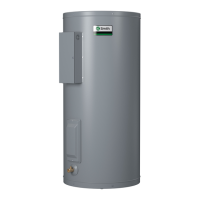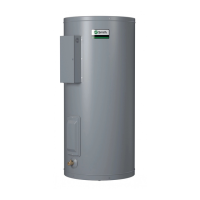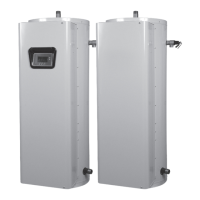8 • Commercial Electric Water Heater Use and Care Guide
Electrical
GENERAL
The installaon must conform with
these instrucons and the local code
authority having jurisdicon and the
requirements of the power company.
In the absence of local codes, the
installaon must comply with the
current edions of the Canadian
Electrical Code CSA C22.1.
An electrical ground is required to
reduce risk of electrical shock or
possible electrocuon. The water
heater should be connected to a
separate grounded branch circuit with
over-current protecon and disconnect
switch. The water heater should be
grounded in accordance with naonal
and local codes.
Voltage applied to the heater should
not vary more than +5% to -10% of
the model and rang plate marking for
sasfactory operaon.
DO NOT ENERGIZE THE BRANCH
CIRCUIT FOR ANY REASON BEFORE THE
HEATER TANK IS FILLED WITH WATER.
DOING SO WILL CAUSE THE HEATING
ELEMENTS TO BURN OUT AND VOID
WARRANTY.
The factory wiring is aached to a
terminal block within the external
juncon box unit. The branch circuit
is connected to the terminal block
within this juncon box. The water
heater should be connected to a
separate, grounded, branch circuit with
overcurrent protecon and disconnect
switch. The water heater should be
grounded in accordance with naonal
and local codes.
BRANCH CIRCUIT
The branch circuit wire size should
be established through reference to
the current edion of the Canadian
Electrical Code CSA C22.1 or other
locally approved source in conjuncon
with the heater amperage rang.
The branch circuit should be sized at
125 percent of the heater rang and
further increase wire size as necessary
to compensate for voltage drop in long
runs.
CALCULATING AMPERAGE/
The dual element heater is factory
wired for connecon to a three wire,
three-phase delta branch circuit, non-
simultaneous operaon. In addion, a
ground conductor is required.
Element connecon is for non-
simultaneous operaon. This means
only one element operates at a me.
The wiring diagram, on page 10, shows
the heater may be eld converted to
simultaneous element operaon by
moving the red wire on “J” terminal to
L1. It is then possible for both elements
to operate at once as determined by
the thermostats. Regardless of element
connecon the heater operates in an
“unbalanced” fashion.
The heater may be eld converted to
single-phase operaon by moving the
wire on L3 of the terminal block to L2.
L3 is not used, see page 10.
The heater, now in single-phase
non-simultaneous operaon, may
be eld-converted to single phase
simultaneous operaon by moving the
red wire on terminal “J” to L1, see page
10.
This is an example of calculang heater
amperage for both types of element
operaon. From this, the branch circuit
conductor and overcurrent protecon
sizing can be established.
Non-simultaneous:
(as factory wired)
Simultaneous:
(Field conversion)
3000 ÷ 240 =
12.5 amps*
3000 ÷ 240 =
12.5 amps*
12.5 x 1.73 = 21.6
amps
*NOTE: as a
single-phase
nonsimultaneous
unit.
*NOTE: as a
single-phase
simultaneous
unit the total is:
12.5 x 2 = 25 amps
The example is of a three-phase 240
volt unit with two, 6 kw elements. The
notaons are for units eld converted
to single-phase. Check the heater
model and rang plate for actual
specicaons and substute those
values in the following.
The rang of the overcurrent
protecon should be computed on
the basis of 125 percent of the total
connected load amperage. Where the
standard rangs and sengs do not
correspond with this computaon, the
next higher standard rang or seng
should be selected.
GETTING STARTED
GETTING STARTED

